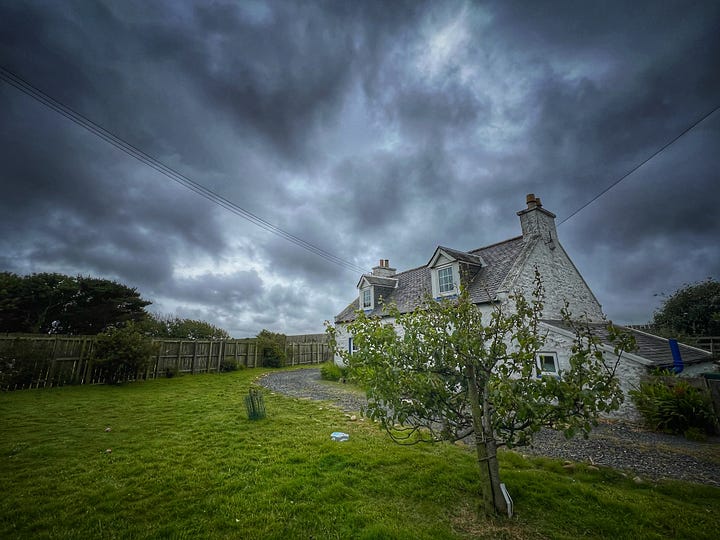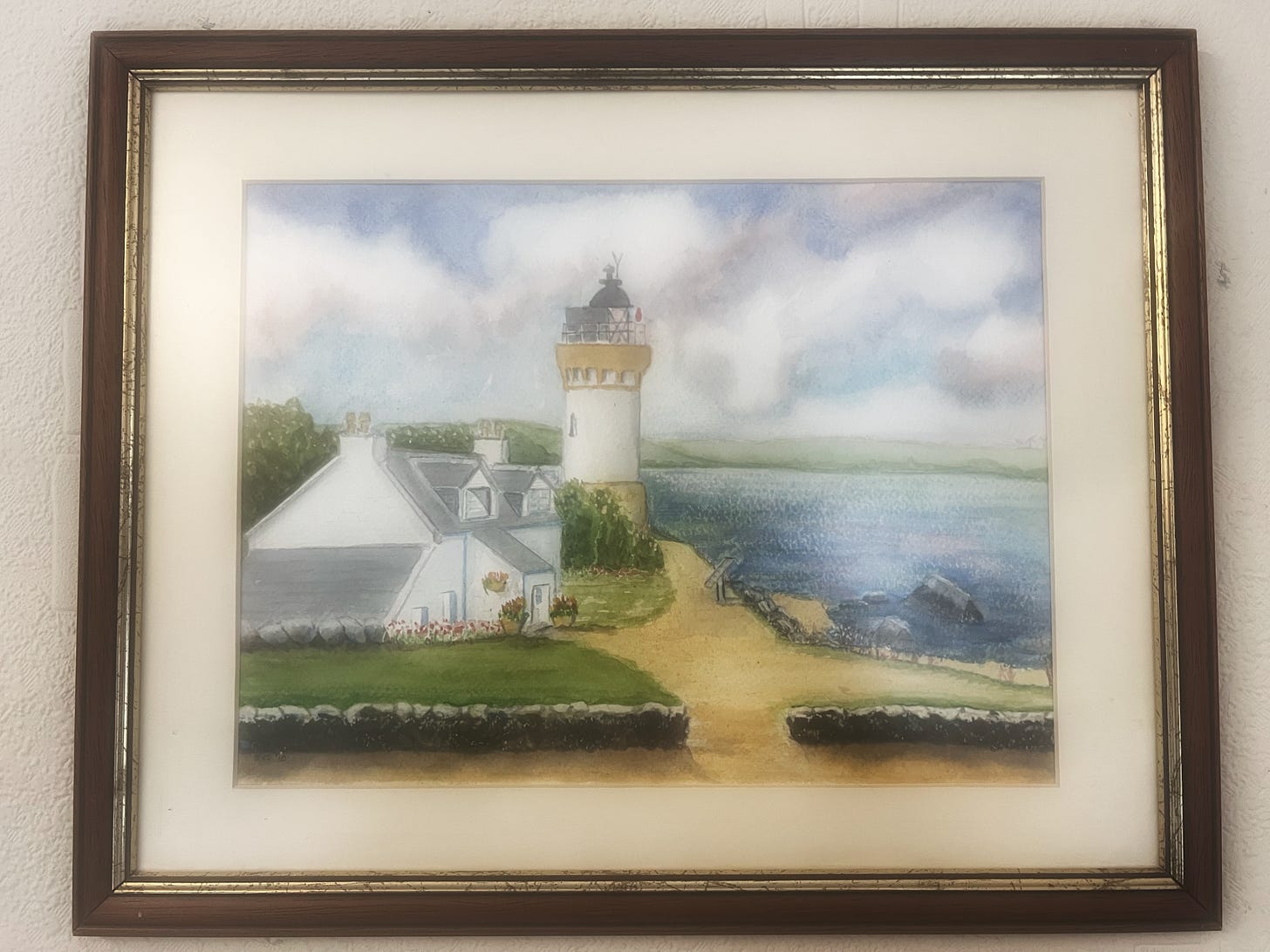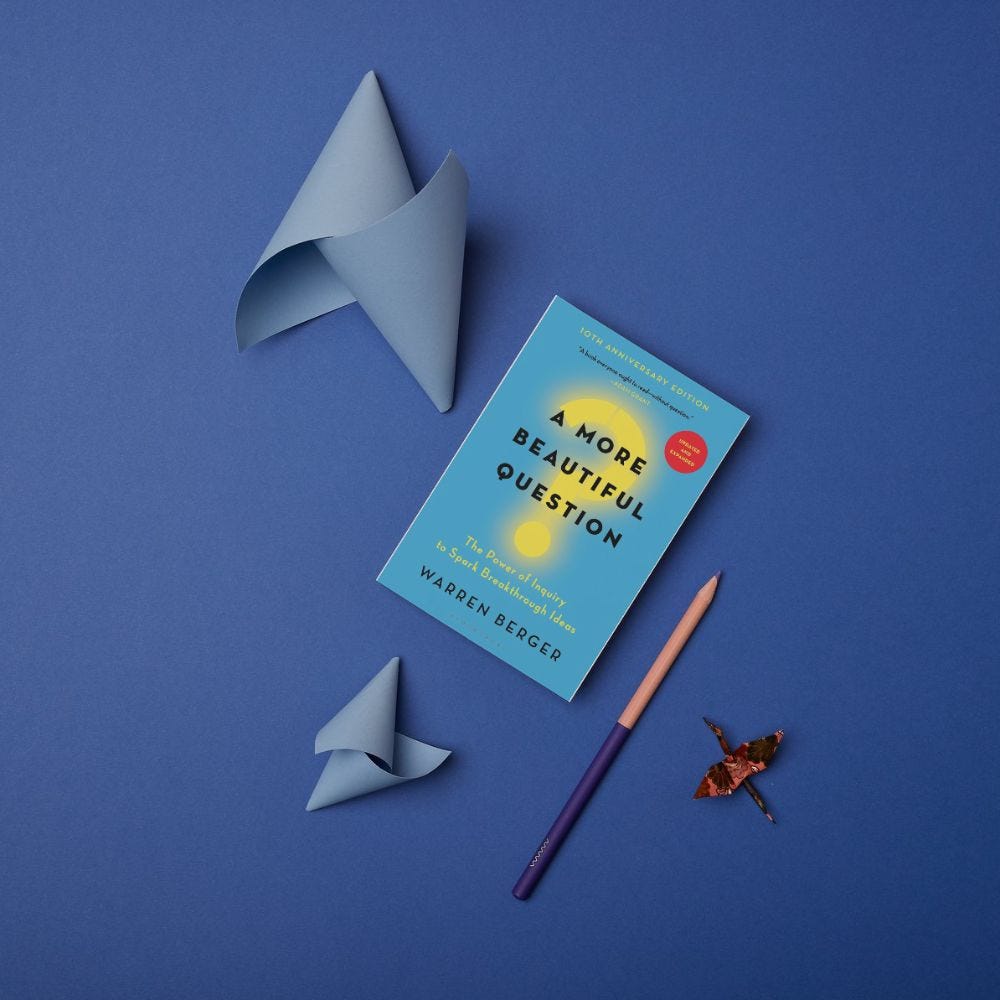Last year, I spent a season with the writing collective Foster1 exploring the transformational power of inhabiting an ambitious yet actionable question that might serve as a catalyst to bring about personal change. The question I formulated, ‘What if I change my mind?’, opened the way for me to begin this newsletter, and to begin this journey on Metanoia Road. Thank you for joining me.
Dear You—
Today, I am writing to you about questions. In my first letter, I wrote about the experience of despair. Despair was that place I inhabited because I couldn’t figure out a way to move through a difficult personal situation2. While I was living in despair, there was only one possible way that things could be: the way they were.
In Ask a More Beautiful Question3, Warren Berger writes this: “Without the ability to conceive of more than one possible way that things might stand in the world, why ask a question?”
In despair, I could not conceive of any other possible way that things might stand in the world. So why ask a question? There was only ever the one question, and I knew the answer. And it was always the same answer. So, I stopped asking questions.
But, in October last year, I accepted an invitation to ask questions. I joined a collective of writers and, with them, embarked on a journey to uncover a resonant, beautiful question; to feel into it, to inhabit it and, finally, to publish a story that arrived from it.
Metanoia Road contains the beginning of that story, and this letter contains the ambitious, beautiful questions that I discovered on that journey. I wasn’t asking questions to get answers. I was asking questions to expand my sense of what was possible. And then I began using them for fuel for some new kind of living, and a new kind of writing, which led me here to Metanoia Road.
I’m about to share a poem of beautiful questions which, back in October, I found too painfully personal to share. They challenged and implicated me in ways I did not wish to be challenged and implicated. Back in October, when I wrote this poem alongside the collective, I first only shared it with one other writer with whom I shared space in a Zoom room during
’s workshop, “Cultivating a Safe Space for Curiosity”. We were together for the duration of two breakout sessions but what occurred between us was staggering. At first, we were two strangers sharing our uniquely personal questions. Next, we were two conjoined souls speaking with the one voice, the universal. It was just as psychologist Carl Rogers said: “What is most personal is most universal.”4What if?
What if I change my mind?
What if I stop thinking we failed?
What if things are just different now?
What if we’ve changed?
What if that’s okay?
What if it’s okay that you’ve been sad?
What if that doesn’t make you less of a man?
What if I don’t have to fix you?
What if I let you walk away?
What if I let you be silent?
What if I say it’s okay, you don’t have to talk?
What if you know that I’ll listen when you do?
What if I don’t have to know everything?
What if it’s okay that you interrupt me?
What if I don’t always have to finish my sentence?
What if I let you be angry with me?
Or just let you be angry? What if it isn’t about me?
What if I don’t need to be angry anymore?
What if I apologise for expecting you’d always be stronger than me?
What if I apologise for expecting you’d always bring more money than me?
What if it’s okay you didn’t buy me a ring?
What if it’s okay you didn’t want a family?
What if we are the family?
What if I’m not the victim?
What if you’re not the victor?
What if we are both crushed?
What if I created this world with you?
What if I accept that you are hurt too?
What if I accept that I hurt you too?
What if we did this to each other; with each other?
What if I remember that you were once a child, just like me?
What if, in growing up, we both lost the same things?
What if I believe you love me?
What if I believe I can be loved?
What if I let you be who you wish to be?
What if I choose to be who I am?
What if I’ve always had that choice?
What if I’ve always been this free?
What if I change my mind?
The architecture of questions
There are three types of beautiful questions for Berger.
‘Why’ questions help us begin to understand complicated issues and are an invitation to begin challenging our assumptions. I stared with ‘why’ to understand the nature of the problem. Looking back, I stagnated with ‘whys’ for far too long—a few years, in fact—before moving onto the next, question.
‘What if’ questions help us break out of our usual patterns of thinking and invite us to explore novel ideas and to make connections between old and new ideas.
I love the phrasal verb BREAK OUT (I think it requires capitalisation!). For a long time, the architecture of my despair was an old, cold, unyielding stone cottage with cross-hatched windows (that looked more like prison windows) so small I would never see sunlight again.
If you look at my early photos of here, you will see brooding and eerie skies and lands. My camera couldn’t quite capture the hard-to-bear dreariness (dreich, in Scots) mood of southwest Scotland as I could so clearly see it, so I obsessively used a photo app to re-create what I was seeing: An ominous, shadowy tapestry of cobalt blue with large heavy sinking canopies of pewter grey and smoky quartz clouds. The land around me was formed in parts with slate and steel; in parts with sponge and moss. And it was like this all the time. In my native Greek, Scotland is Σκωτία (Skotia) which sounds eerily like σκότος (skotos)—darkness.


Sometime last year, a couple who walk their dog by the cottage, stopped to tell me some news. They’d seen a painting of my cottage on Facebook Marketplace. They said I should head into town to get it. I made the connection with the painting’s owner (who was not the artist), and Henri and I drove right into town to meet her and purchase the painting.
When we arrived, there she was, the woman with the painting. She held it out—unemotional, detached. I was surprised. The painting looked strange, wrong. I recognised the cottage but it was painted into a landscape for which the artist had chosen a pastel palette. The sky was a calming pastel blue. The landscape was a healing pastel green. Everything was soft and gentle and pleasant. I imagined I could skip around that cottage, in the lightest cotton floral dress and never need my waterproof boots and coat again. And the cottage, the cottage looked warm and inviting.
How had the artist seen this muted palette in the landscape where I saw ominous, dark drama?
I hung the painting on the kitchen wall by the main corridor which meant I would see it many times a day. And each time I walked past that wall, I paused and looked at the painting. I began to ask myself:
What if there is peace here?
What if there is light?
What if this cottage is warm and inviting?
These three “what if” questions, as well as all the “what ifs” of the poem above, have radically transformed my architecture—internal and external.
I began to feel the cottage breathe. I saw its stone walls buckling and undulating, fluid and organic. Its windows, previously shut dead tight, now blew open to invite inside sun and sea breeze like children laughing. The entire cottage was transforming, vibrating, glowing. Everything had expanded.
I too had begun to breathe again, to soften and glow and expand.
The ‘what if’ questions I have been asking are challenging. They implicate me in all I see and feel about the state of my world. If I can co-create an ominous world, I can co-create a brave new world. That’s the power of the ‘what if’.
And so I come to the third type of question.
‘How’ questions are the most difficult questions. They invite action and change. They invite you to live the question; to inhabit the question. In the words of the Foster collective, “to inhabit a question fully is to bring it from your head down into your body, and allow it to guide you into new choices you wouldn’t otherwise make.”
It’s been quite a journey going from “Why should I change my mind” to “What if I change my mind” to “How might I change my mind”. Yes, the first two questions are still very much intellectual questions. This third one, however—How might I change my mind?—this is the one I inhabit now. This is the one I live.
—Until my next letter,
Meet me in the comments section:
What is your “ambitious yet actionable question that can shift the way you perceive or think about something”? What is the question that “might serve as a catalyst to bring about change”? What is your beautiful question?
Join me in the comments (or just reply to this email):
What is a problem you can’t see your way out of?
First, ask ‘why’ to determine the nature of the problem.
Next, ask ‘what if’ to explore what is possible.
Finally, ask ‘how’ to explore ways to take action.
See ‘Welcome to Metanoia Road’ and Brené Brown’s Atlas of the Heart.
A More Beautiful Question by Warren Berger explores the power of inquiry to spark innovation and creativity. Berger delves into how asking the right questions can lead to significant breakthroughs in business and personal life. He provides examples from various fields, showing how transformative questions can lead to deeper understanding and novel solutions. The book encourages readers to embrace curiosity and to see questioning as a critical skill for success. For me, this book led me to ask a more beautiful question which radically transformed how I saw my self, my role and my responsibility in a key personal relationship. I’d love to know your responses to this book’s invitation to ask a more beautiful question. Just hit reply to this email or join me in the comments section.













I love that another artist’s perspective on your home allowed you to look at it differently. OK - I prefer your moody photos of it to the pastel version but hey, sometimes it snows in April as Prince once pointed out ❤️
hello from hot sunny lesvos, greece!
when i read the title of this post i almost didn't want to read the rest of it because the title alone stopped me in my mental tracks. i read those six words from a buddhist perspective that tells us that our world is in our mind. how can i change the world that inhabits my mind and is a reflection of that mind? the title alone rocked my day! in what way can i see the world differently by making fundamental changes in my mind? while i have no control over events in the world, or even my tiny world, if i change my mind i might be able to see and respond to them differently. i know that changing my mind is not a simple task, as easy as it sounds. this change is not in response to a person or situation; rather it's in my point of view, perspective. it's architectural, possibly changing the fundamental arrangement of my heartmind.